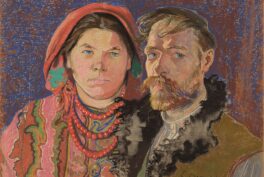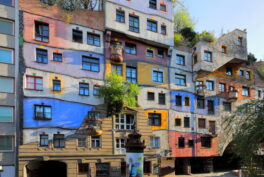Summary
- Élisabeth Vigée Le Brun was born in 1755 and displayed great talent from a young age. When she was 14, after her father’s death, Vigée Le Brun began painting and selling portraits to help support her family.
- Vigée Le Brun’s rates became the highest in all of Europe and she would soon develop an exclusive clientele— but no one more exclusive than Queen Marie Antoinette of France.
- Vigée Le Brun became the queen’s official court portraitist, but in 1879 the onset of the French Revolution would force the artist out of Paris and into some of the most important European courts of the time.
- Vigée Le Brun eventually returned to France and spent her final years writing her memoirs, in which she recounts her life and career in great detail.
The Making of an Artist
Born on April 16, 1755, in Paris, Élisabeth Vigée Le Brun displayed artistic skill from the time she was a young girl. Her father, a pastel portraitist, adored his daughter and encouraged her artistic endeavors. “If ever there was a painter, it’s you, my child,” he told her. She was exceedingly talented, despite having had no formal training. When Vigée Le Brun was 12, her father fell ill and died, marking one of the most difficult moments of her life. She was soon obliged to work to help pay for her brother’s schooling. At age 14, after painting two beautiful portraits of her mother and brother, commissions began flooding in and she began receiving payment for her paintings. Her fees would soon be the highest in all of Europe.
Portraiture
Portraits were the only way to immortalize one’s likeness before the invention of photography in the mid-19th century. With a growing wealthy middle class in Europe, the art form became increasingly popular. Vigée Le Brun would soon discover that being a portraitist also involved entertaining her sitters, sometimes for hours at a time. Luckily, she was known to be charming and a great conversationalist. She developed an exclusive clientele, many of whom were nobles and aristocrats, including rich older men who would stare at her while she painted them. This became so uncomfortable for the artist that she devised a strategy to divert their gaze—she would ask her sitters to look up into the distance, telling them she needed to paint their eyes. This gaze began making an appearance in much of the art of the time, and Vigée Le Brun is said to have invented it.
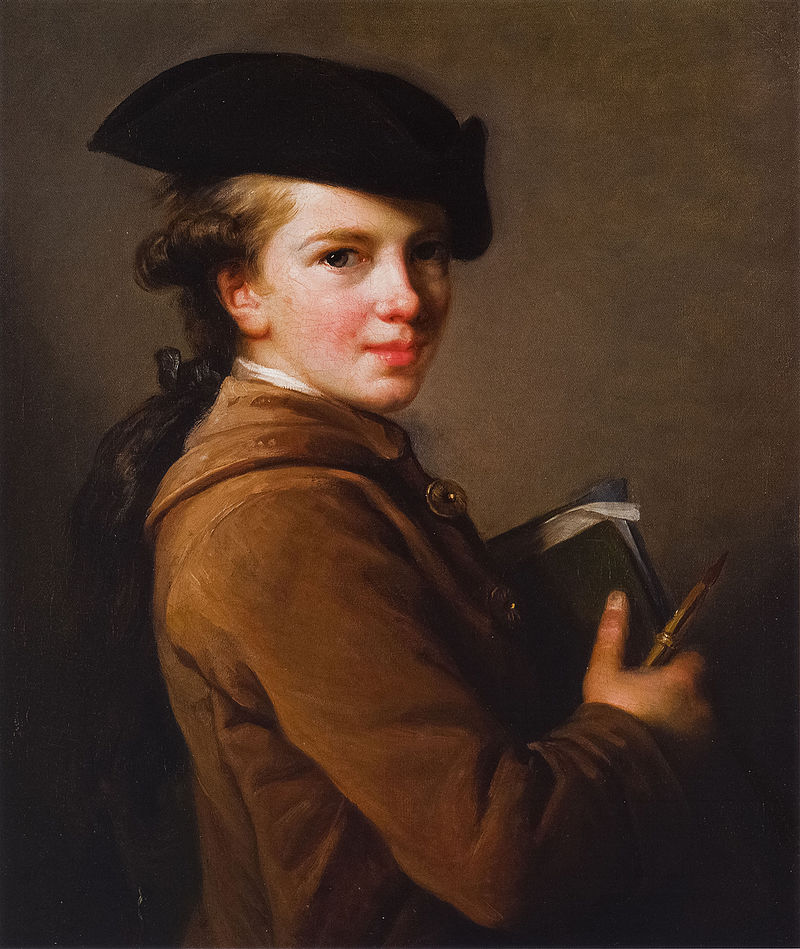
Élisabeth Louise Vigée Le Brun, Portrait of Artist’s Brother, 1773, Metropolitan Museum of Art, New York, NY, USA.
Marriage
Le Brun’s earnings provided a comfortable life for her family. Her mother would eventually remarry, but unfortunately for Vigée Le Brun, her stepfather would squander most of her money. In 1774, she entered an official school, joining the Académie de Saint-Luc artist guild, just as her father had decades earlier. Two years later, at the age of 20, Vigée Le Brun married Paris’s premier art dealer, Jean Baptiste Pierre Le Brun. The two shared a love of art, but not much more.
So little, however, did I feel inclined to sacrifice my liberty that, even on my way to church, I kept saying to myself, “Shall I say yes, or shall I say no?” Alas! I said yes, and in so doing exchanged present troubles for others.
The couple would eventually welcome a daughter, Julie, whom they would refer to as Brunette. Sadly, Vigée Le Brun’s husband would prove to possess the same qualities as her stepfather. He, too, would gamble away most of her hard-earned money.
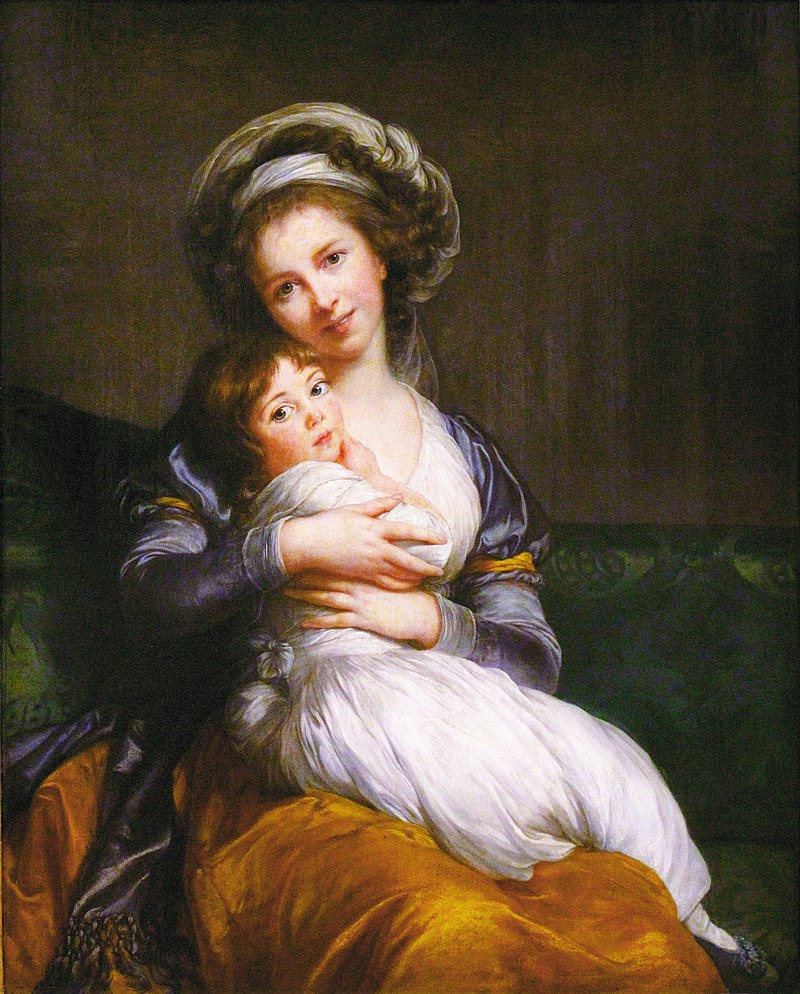
Élisabeth Louise Vigée Le Brun, Self-Portrait with her daughter Jeanne Lucie, Julie, 1786, Louvre, Paris, France. Wikimedia Commons (public domain).
Madame Le Brun, The Queen’s Painter
Queen of France Marie Antoinette was known to have disliked any portraits of herself—that is, until she met a woman by the name of Vigée Le Brun. The queen had heard of Vigée Le Brun’s success as a portraitist and in 1778 summoned the artist to her court to paint her portrait. Fortunately, Vigée Le Brun’s execution did not disappoint, and she was soon appointed the queen’s official portraitist.
Vigée Le Brun and Marie Antoinette would become confidantes. Affectionately known as Madame Le Brun at court, the artist would paint over 30 portraits of the queen and her family. In 1783, with the support of the queen, she was admitted to the Royal Academy and began submitting to the Paris Salon. Vigée Le Brun’s portraits were simple, yet stylish. Distinguished, yet approachable. She loved the natural beauty of her sitters and was known to ask them to remove thick makeup and let down their hair.
She wrote of Marie Antoinette:
…the most remarkable thing about her face was the splendor of her complexion. I never have seen one so brilliant, and brilliant is the word, for her skin was so transparent that it bore no umber in the painting. Neither could I render the real effect of it as I wished. I had no colors to paint such freshness, such delicate tints, which were hers alone, and which I had never seen in any other woman.

Élisabeth Vigée Le Brun, Marie Antoinette in a Chemise Dress, 1783, The Metropolitan Museum of Art, New York, NY, USA. Museum’s website.
In 1783, Marie Antoinette agreed to do away with her large stiff gown, accepting instead to be depicted in a simple muslin dress. The queen of France wearing no jewelry and no traditional whalebone corset caused an outrage. It was the first time a queen’s portrait lacked a reference to her status. For the queen to agree to such a thing was scandalous—a fashion revolution led by the queen and her painter.
Self-Portrait with a Straw Hat
In 1781, Vigée Le Brun traveled to Flanders and the Netherlands with her husband for business. Seeing the work of Flemish masters had a profound impact on her. Peter Paul Ruben’s Woman with Straw Hat particularly struck her, especially when she noticed that the sitter wasn’t wearing a straw hat at all. When Vigée Le Brun returned to Paris, she corrected his mistake in what would become her most famous portrait.
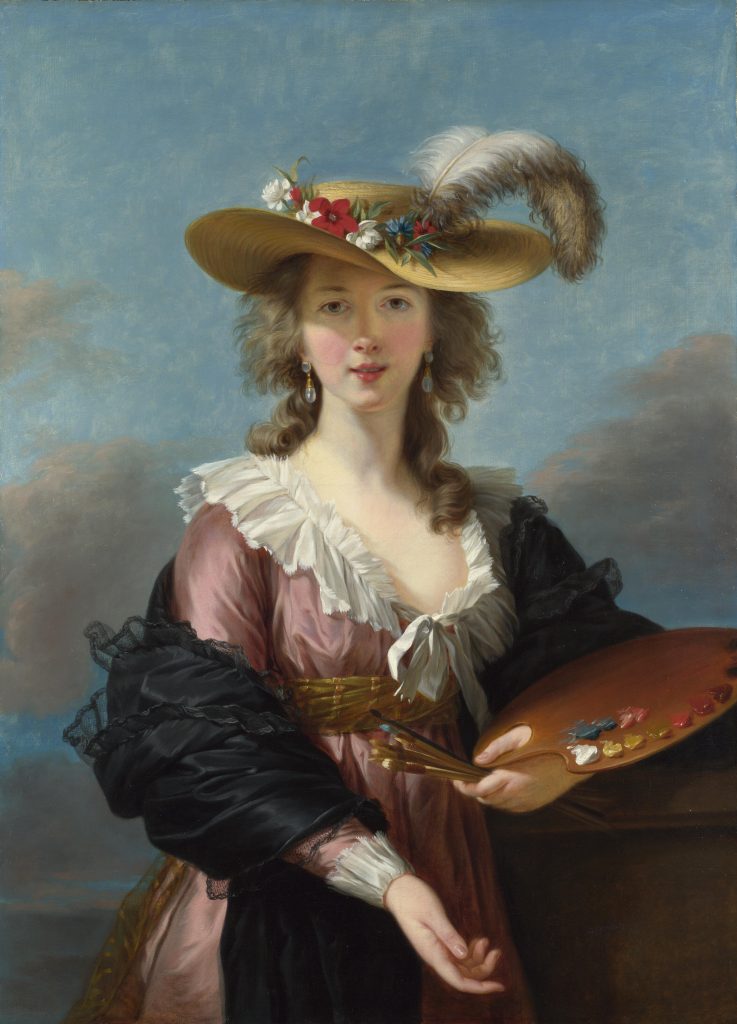
Élisabeth Vigée Le Brun, Self Portrait in a Straw Hat, 1782, National Gallery, London, UK. Wikipedia.
Trouble Brewing
Back home, Marie Antoinette was becoming increasingly unpopular among French citizens. In an effort to change the image of the queen in the eyes of the people, Vigée Le Brun decided to create a portrait of her that would bring out her humanity. In 1787, she painted a tender portrait of Marie Antoinette with her three children. The empty crib signified the queen’s youngest child, a little girl who had recently passed away.
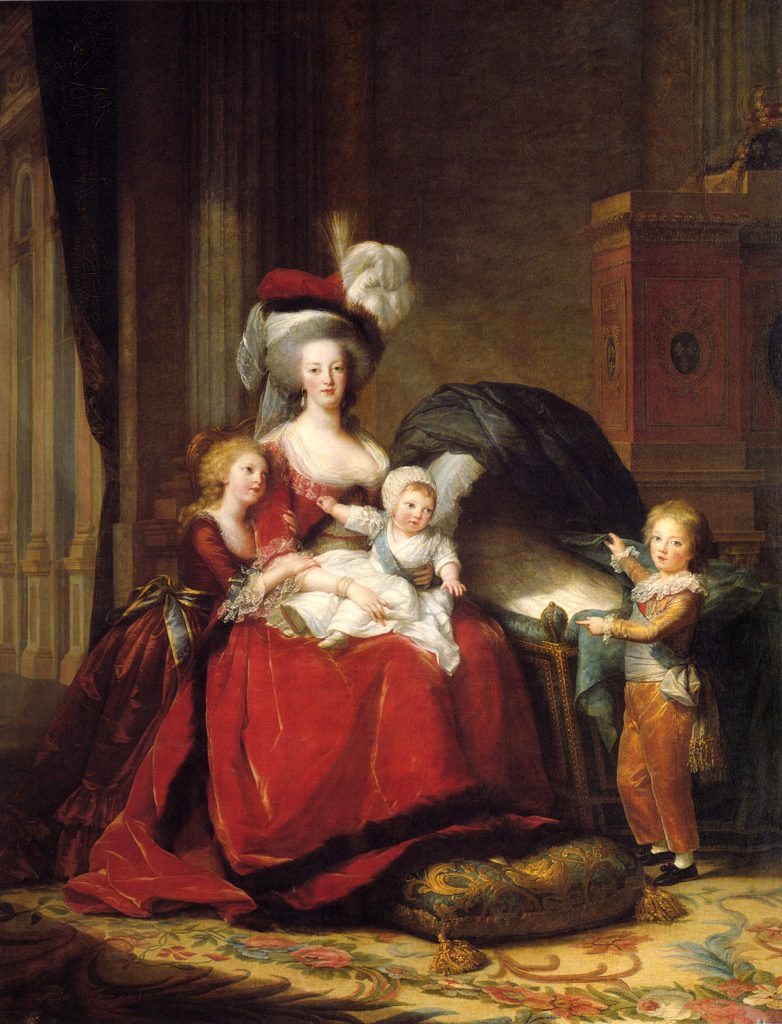
Élisabeth Vigée Le Brun, Marie Antoinette and her Children, 1787, Palace of Versailles, Versailles, France.
The portrait, however, would prove unconvincing. Indeed, it did not change the people’s opinion of their queen, and in 1789 the French Revolution began. With Paris under siege, and violent rages plaguing the capital and its suburbs, Vigée Le Brun did what she had to do: she left France in exile.
Travels
Vigée Le Brun would spend the next 12 years traveling throughout Europe. Her close ties to the royal court meant she would be in danger if she returned to France. She took her daughter, leaving her husband behind (the two would eventually divorce). What was meant to be a short self-imposed exile turned into the artist’s own version of the Grand Tour, a rite of passage for young students and painters of the time who wished to refine their education. Her travels took her to all the royal courts of Europe—Italy, Austria, England, and Russia—where she painted nobility. All the while, so as not to be forgotten, she continued to submit her work to the Salon.
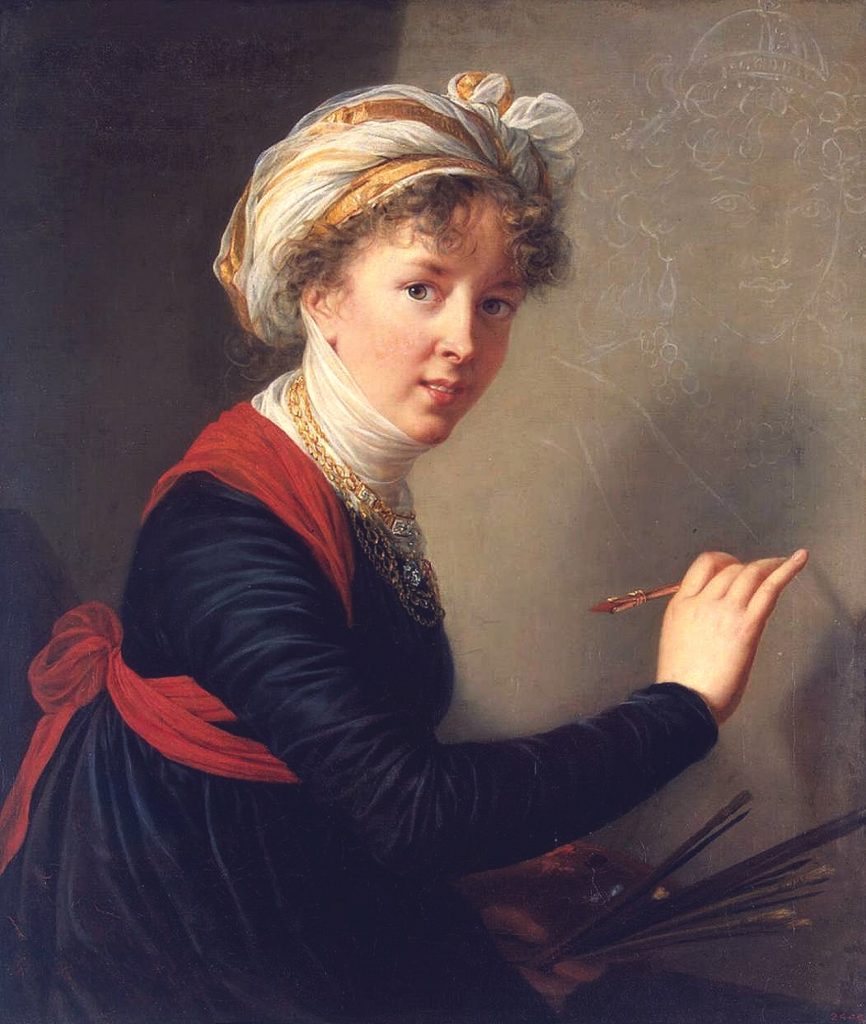
Élisabeth Vigée Le Brun, Self-Portrait, 1800, Hermitage Museum, Saint Petersburg, Russia.
Celebrity Sitters
In Italy, she visited Rome, Bologna, Florence, Naples, and Venice, where she studied the works of the great masters. While in Rome, she was invited to paint a portrait of the Pope but declined when the Vatican demanded she wears a veil. In 1792, Vigée Le Brun traveled to Vienna, where she would stay for three years and painted diplomats. While there, she would receive the sorrowful news of Marie Antoinette’s execution. In the summer of 1795, Vigée Le Brun traveled to St. Petersburg, where she would remain for the next six years. She was welcomed by new clientele—luckily, all Russian nobility spoke French. At the time, Russia was known as the land of the new Renaissance, and Vigée Le Brun found inspiration in the recent Greco-Roman findings in Pompeii and Herculaneum.
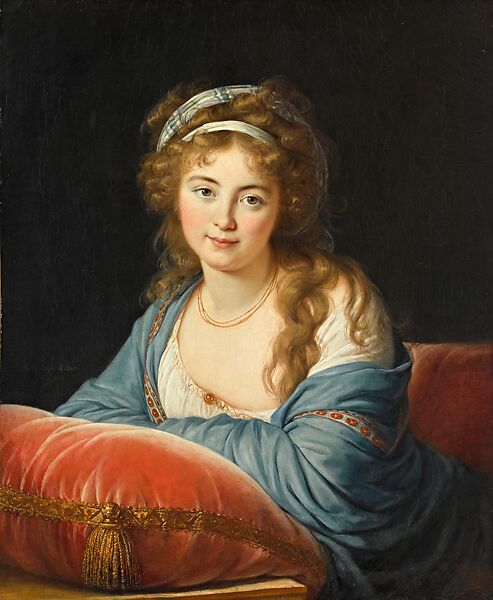
Élisabeth Vigée Le Brun, Countess Skavronskaia, 1796. Metropolitan Museum of Art, New York. Museum’s website.
Heartache at Home
After nearly thirteen years abroad, Vigée Le Brun returned to Paris in 1802. But her homecoming was far from joyous. She found the country had changed significantly—especially under Napoleon’s rule. Her melancholy was furthered when she visited her daughter in Paris. Sadly, her dear Brunette was on the brink of death, most likely due to a complication of syphilis.
Vigée Le Brun spent her last years writing a memoir—a different kind of self-portrait, this time in written form. It concludes:
…I hope to end peacefully a wandering and even a laborious but honest life.
Vigée Le Brun passed away in 1842 quietly at 87 years old. Despite her personal grief, it is safe to say that her final wish had most certainly been fulfilled. She had built a business, traveled the world, experienced revolutions, and met the greatest rulers of her day. Today she is known as France’s last great portraitist.

Élisabeth Vigée Le Brun, Self-Portrait, 1790, Uffizi, Florence, Italy.



